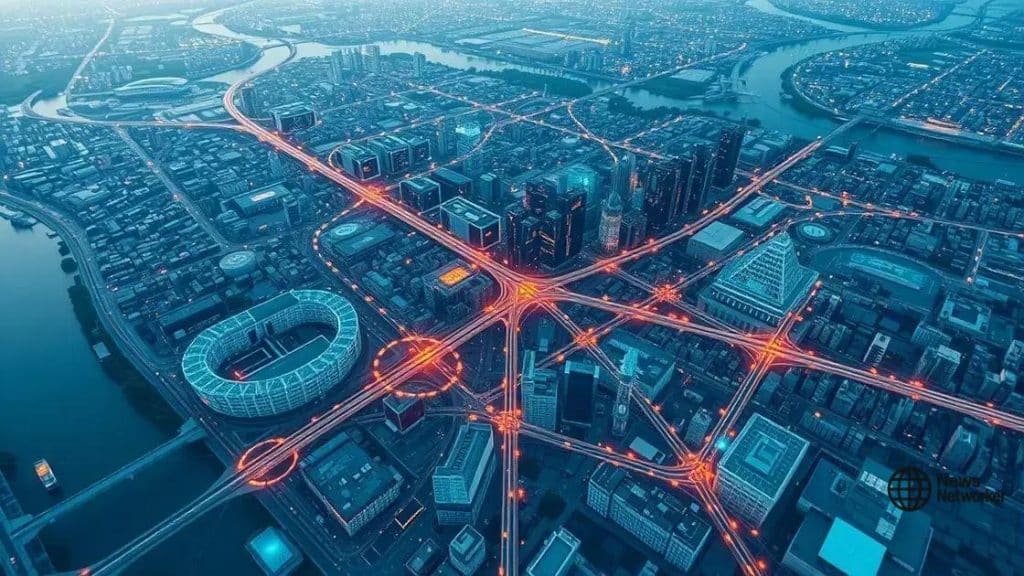Digital twins: revolutionizing urban planning for cities

Digital twins revolutionize urban planning by creating virtual models of environments, enabling efficient decision-making, sustainability, and enhanced citizen engagement through real-time data analysis and simulations.
Digital twins are transforming how we approach urban planning and infrastructure development. Imagine a virtual replica of a city, allowing real-time monitoring and smarter decision-making. This technology is not just a concept; it’s a practical solution shaping our urban environments.
Understanding digital twins in urban planning
Understanding digital twins in urban planning is crucial for creating smarter, more efficient cities. These virtual models allow urban planners to simulate building designs, infrastructure, and even entire neighborhoods before actual construction takes place. By leveraging real-time data, city officials can make informed decisions that enhance sustainability and improve the quality of life for residents.
A digital twin acts as a dynamic digital replica of physical assets. It uses real-time data to reflect the current state of buildings, roads, and public spaces. This means planners can identify problems and test solutions virtually, which saves time and resources. With the integration of various data sources, such as sensors and IoT devices, digital twins help in monitoring infrastructure conditions live.
Key Benefits of Digital Twins
Implementing digital twins comes with several advantages that can change urban planning for the better:
- Enhanced visualization of projects, making it easier to communicate ideas.
- Improved resource management thanks to data-driven insights.
- Increased efficiency in construction by identifying potential issues early.
- Better stakeholder engagement through interactive simulations.
Moreover, these tools enable real-time collaboration among teams, leading to more cohesive project management. City planners can share insights instantly with all involved parties, ensuring everyone is on the same page. The result is a more connected and prepared response to urban challenges.
Another important aspect is the predictive capabilities of digital twins. For instance, if a city plans to implement a new public transport system, planners can use a digital twin to simulate how it will affect traffic flow. By testing various scenarios, they can adjust plans to minimize congestion and enhance public accessibility.
In understanding digital twins in urban planning, it’s evident that these tools are more than just models; they represent a shift towards a data-centered approach in city management. As cities grow, the need for such innovative solutions will only become more apparent, ensuring urban areas remain livable and efficient for future generations.
Benefits of digital twins for infrastructure
Digital twins provide numerous benefits for infrastructure management and development. By creating a virtual model, city planners can gain insights and improve operations. This technology enables a dynamic interaction between the physical and digital realms, enhancing decision-making processes and facilitating proactive maintenance.
Key Advantages of Digital Twins
Digital twins empower infrastructure projects in several impactful ways:
- Predictive maintenance: By monitoring data in real time, assets can be maintained before problems arise. This prevents costly outages.
- Improved design accuracy: Simulating multiple scenarios helps teams optimize designs and ensure they meet user needs efficiently.
- Enhanced collaboration: Stakeholders can access the same model, leading to better communication and fewer misunderstandings throughout the project lifecycle.
- Resource optimization: Data-driven decisions can lead to more effective resource allocation, reducing waste and costs.
Moreover, digital twins facilitate continuous improvement. As cities grow and evolve, these models can adapt, allowing for updated strategies to address emerging challenges. This adaptability ensures that urban planners remain agile in the face of new developments.
Additionally, these tools help in assessing the impact of environmental factors on infrastructure. For example, a digital twin can simulate how heavy rainfall might affect a drainage system. By predicting these scenarios, cities can upgrade their systems preemptively, safeguarding against potential failures.
Furthermore, the integration of public feedback becomes easier with digital twins. Citizens can visualize proposed changes and express their opinions, fostering community engagement. As a result, urban planning becomes more inclusive and responsive to the needs of the population.
Real-world applications of digital twins

Real-world applications of digital twins showcase how this innovative technology is changing various industries. From urban planning to manufacturing, digital twins provide valuable insights that enhance efficiency and effectiveness.
Urban Planning
In city development, digital twins are used to simulate urban environments. For example, planners can visualize the impact of new buildings on traffic flow and public spaces. This simulation allows them to identify potential issues before construction begins, saving time and resources.
- Traffic management: Digital twins help analyze traffic patterns and optimize signals, reducing congestion.
- Infrastructure monitoring: These models track the health of roads and bridges, enabling proactive maintenance.
- Community engagement: Citizens can interact with digital twins, providing feedback on proposed developments.
Another significant application of digital twins is in the energy sector. Utility companies use these models to monitor grid performance in real time. This capability allows for quick responses to outages and efficient energy distribution.
Healthcare Innovations
Digital twins in healthcare create patient-specific models based on real-time data. These models can simulate how a patient might respond to various treatments, allowing doctors to personalize care plans. This approach enhances decision-making and improves health outcomes.
Furthermore, in manufacturing, companies utilize digital twins to improve production processes. By analyzing machine performance and production flow, businesses can identify bottlenecks and increase operational efficiency. This leads to reduced downtime and higher quality products. The integration of digital twins also supports the design of new products by allowing for rapid prototyping and testing in a virtual environment.
As industries continue to adopt digital twins, we can expect more innovative solutions to emerge. This technology fosters collaboration, enables better planning, and ultimately leads to improved services for society at large.
Challenges in implementing digital twins
Implementing digital twins presents several challenges that organizations must navigate to fully leverage their potential. While the benefits are significant, roadblocks can complicate the adoption process.
Data Integration Issues
One major challenge is the integration of data from various sources. Digital twins require seamless access to real-time data from multiple systems. When data is siloed or inconsistent, it can hinder the effectiveness of the digital twin model.
- Inconsistent data formats: Different systems may store information in various formats, making integration difficult.
- Real-time data requirements: Ensuring data is continually updated for accuracy can strain existing infrastructure.
- Data security concerns: Handling sensitive information raises security risks that must be addressed during implementation.
Moreover, the lack of standardized measures for creating digital twins can complicate the process. Organizations may face difficulties in defining the scope and objectives when developing these models.
Cost and Resource Allocation
Another challenge is the initial cost of implementing digital twins. The technology requires significant investment in software, hardware, and skilled personnel. Many organizations struggle to justify these expenses, especially if the return on investment is not immediately clear.
Additionally, companies need to allocate resources for training employees. Adopting digital twin technology often entails a learning curve, which can slow down the deployment process. As teams become more familiar with the technology, they may need ongoing support and guidance to maximize its benefits.
Finally, cultural resistance within organizations can impede the success of digital twin initiatives. Employees accustomed to traditional methods may be hesitant to embrace new technologies, which can slow progress. Overcoming this resistance requires strong leadership and effective change management strategies to foster a culture open to innovation.
The future of urban planning with digital twins
The future of urban planning with digital twins looks promising, offering groundbreaking solutions to complex challenges. As cities grow larger and more interconnected, leveraging technology becomes essential for sustainable development.
Smart City Integration
Digital twins will play a crucial role in creating smart cities, where data and technology work together to enhance the quality of life. By simulating urban environments, planners can make informed decisions that impact everything from energy usage to traffic management.
- Efficiency: Digital twins help optimize resource allocation, reducing waste and minimizing costs.
- Sustainability: These models can simulate the effects of urban design on the environment, helping to create greener, more eco-friendly cities.
- Public safety: Real-time data integration allows for timely responses to emergencies and better public health management.
Moreover, the ability to run “what-if” scenarios will enable planners to test different strategies before implementation. For instance, they can analyze how new transportation routes will affect traffic patterns or evaluate the impact of new buildings on community infrastructure.
Enhanced Citizen Engagement
As urban planning evolves, so does the role of public engagement. Digital twins will enable citizens to visualize and interact with proposed developments. This transparency fosters community involvement in decision-making, leading to plans that genuinely reflect the needs of residents.
Furthermore, incorporating citizen feedback into the planning process will improve overall project outcomes. By understanding real-time public sentiment, planners can adjust their strategies accordingly, creating more resilient urban environments.
In conclusion, the future of urban planning using digital twins is set to revolutionize how cities operate. By integrating technology into every aspect of urban design, cities can become more efficient, sustainable, and responsive to the needs of their citizens. As this technology continues to develop, the possibilities for innovative urban solutions are limitless.
The future of urban planning with digital twins is incredibly exciting. This technology offers a smarter way to design and manage cities, leading to improved efficiency, sustainability, and community engagement. By integrating real-time data and simulations, planners can make better decisions that directly benefit residents. As we embrace digital twins in urban development, the possibilities for creating resilient and vibrant cities are endless. Emphasizing collaboration and innovation will pave the way for a brighter urban future.
FAQ – Frequently Asked Questions about Digital Twins in Urban Planning
What are digital twins in urban planning?
Digital twins are virtual models of physical spaces, helping planners simulate and analyze urban environments for better decision-making.
How do digital twins enhance citizen engagement?
They allow citizens to visualize proposed developments and provide feedback, fostering a collaborative planning process.
What benefits do digital twins offer for sustainability?
Digital twins can simulate environmental impacts, enabling cities to design eco-friendly initiatives and optimize resource use.
What challenges are associated with implementing digital twins?
Challenges include data integration, high initial costs, and potential cultural resistance within organizations.





